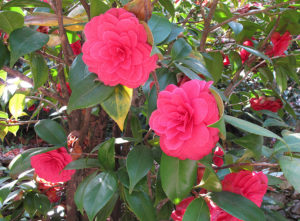
The advent of spring in Tuscany is heralded by the annual opening to the public of the hidden camellia gardens above Lucca at Antiche Camelie della Lucchesia. The scene is very inviting: medieval architecture, villas, the Tuscan landscape and the first warm breezes make the journey to the gardens a must for those who enjoy outdoor events and a touch of nature.
For the past 30 years, two small villages in Tuscany are the setting for the Ancient Camellias festival. Sant’Andrea di Compito and Pieve di Compito lie at an elevation of 1000 meters (3,000 ft.) with cool, shady woodlands with streams and brooks providing the optimum environment for the camellia. From medieval times to the Renaissance, silk was spun into textiles in the city below, Lucca, 12 kilometers (seven miles) south. Merchants had a thriving business in the Orient, eventually importing camellias for their homes and villas in the 1800s. The plants would find their ideal home in the surrounding hills.
For a live report, visit our blog post.
Exiting from the highway up the winding road to the camellia villages, one enters the slow pace of the Tuscan countryside with dry stone walls, carefully tended villas and gardens and ancient bridges crossing streams which come down from Monte Pisano.
The cool, clear water in these parts is one reason why the camellia thrives in this part of Tuscany. That and the clean air, and an elevated habitat not far from the sea, hence temperate, sheltered by nearby mountains.
The camellia’s genus camellia japonica provides a hint of the shrub’s origin and a related species camellia sinensis, which originated in SW China, is what we know as the tea plant; besides beautiful blossoms, camellias are the source of a beverage loved the world over.
March 16, 17, 23, 24, 30, 31; April 6 and 7: ANTICHE CAMELIE DELLA LUCCHESIA. Hours: 10 am to 6 pm. Admission: €7, free to children under 12. Combined ticket with admission to Villa Reale di Marlia €12. Villages are closed to traffic, but visitor parking is mandatory in a designated area at Frantoio Sociale del Compitese with free shuttle provided to the villages. Guests should allow two hours on foot to visit all the venues. For complete information, visit the website.
As mentioned, the geographical position of Pieve and San Andrea favored this exotic import, becoming the camellia towns in the 18th century when the locals started cultivating the plant also for their leaves used to manufacture tea. The tradition continues, and has become so popular that every year thousands of people visit the towns to see the camellias, in a multitude of colors, in full bloom. A trail—an ancient pilgrim road older than the via Francigiana, known as the via di San Colombano—leads between the two towns, and is lined with blossoming camellias.
The Camelieto, a 7,250 square-meter nature reserve, provides a first-hand view of the variety of camellias. Visitors can stroll up the terraced hillside flanked by stone walls to enjoy flowers in hues varying from red to pink or white, in full bloom. Next to a brook, are over 1000 camellia plants as well as trails and picnic areas.
The 2019 edition of the Antiche Camelia della Lucchesia is organized around four themed weekends dedicated to botany, tea, food and music in 12 venues spread throughout the villages. In addition, local villas and gardens will open to the public
Villa Orsi, nestled on a steep hill in Pieve di Compito, has been in the Orsi family for more than 200 years. Open for the festival, the gardens contain numerous centuries-old camellias. Villa Borrini in Sant’Andrea di Compito contains a camellia garden which the public can visit during the event. It was 18th century resident Angelo Borrini’s passion for the plant that established the first camellias in Tuscany. Since 1987, a Borrini family member manages Italy’s only tea plantation and offers his tea for sale to guests. Perhaps the grandest palazzo open during the festival is the Villa Reale di Marlia. The Renaissance villa north of Lucca with beautifully landscaped grounds, gardens and a lake was the home of Elisa Bonaparte Baciocchi, sister of Napoleon and the Grand Duchess of Tuscany.
Themed Weekends
March 16-17: BOTANY. A bust honoring Swedish botanist Carl Peter Thunberg will be unveiled. Thunberg first introduced the camellia to Europe in the 18th century after bringing cuttings back from his time in Nagasaki, Japan. An exhibition of bonsai plants will also be inaugurated.
March 23-24: TEA. On the program is an international tea fair with wholesalers showing a diverse variety of teas and accessories from around the world. Visitors can sample different varieties and observe rituals and tea ceremonies from Japan, Korea and China.
March 30-31: FOOD. The festival continues with displays of local products used in Tuscan cuisine including olive oil, cheese, honey, beans and charcuterie in collaboration with the Slow Food organization. Several restaurants and bars offer special menus for the event.
April 6-7 MUSIC. Visitors can choose among several concerts featuring local musical groups, including an ensemble of students from Lucca’s music school, which will be accompanied by an exhibition of kimonos and musical instruments. (rita kungel & rosanna cirigliano/additional reporting by gréta szabo)








